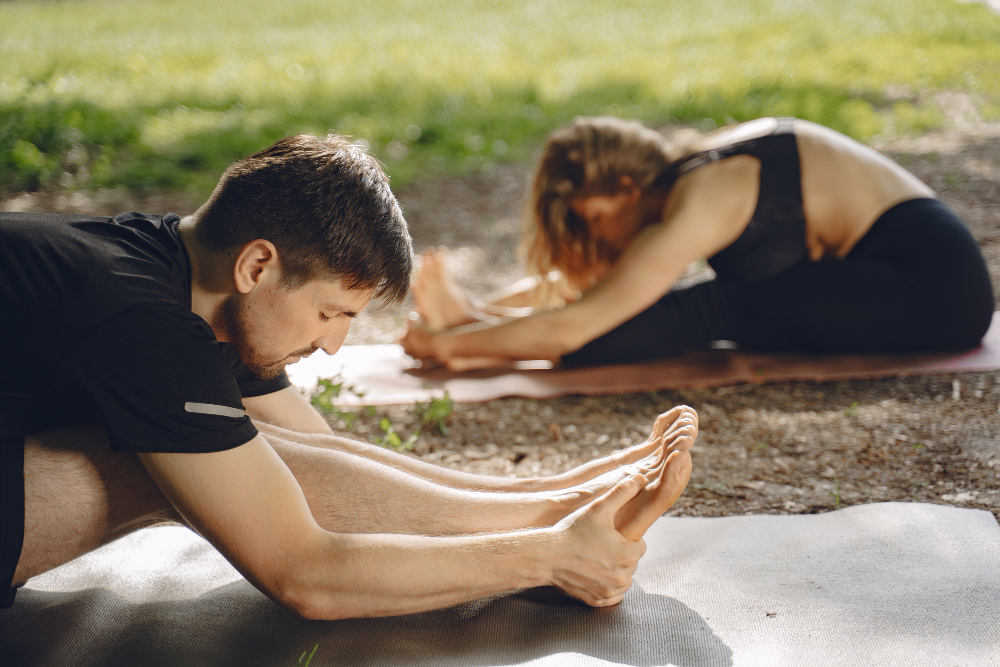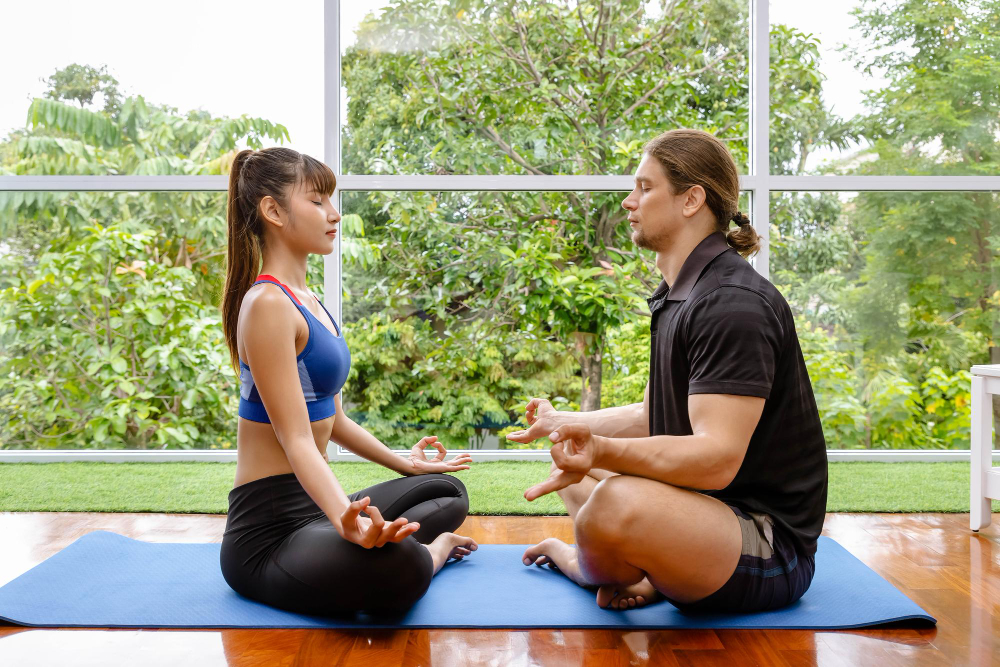If you want to find a way to build a stronger connection with your partner, yoga is a great option. Couples yoga is known for fostering stronger relationships and intimacy, as well as reducing stress.
Couples yoga helps you strengthen your relationship by allowing you to bond through assisted poses. It can help you to communicate better, increase intimacy and improve your sex life.
-
Improved Communication
Yoga is an ancient philosophy that can have a positive impact on your relationship. It helps improve your physical health and libido, while also increasing self-awareness and confidence.
Practicing yoga with your partner is an excellent way to strengthen your communication and bond together. It also has a variety of other benefits, from improving your emotional well-being to helping you reduce stress and anxiety.
While most people think of yoga as an exercise, it’s also a form of meditation that promotes peace and self-awareness. Having a partner to practice yoga with can help you achieve these goals while having fun and strengthening your bond.
When practicing yoga with your partner, it’s important to communicate how to do the poses properly. This includes making sure that both partners are in the right position and are aware of each other’s breathing.
It’s also important to communicate that each partner has different muscle sensitivity and body regions that may need extra support during certain poses. By expressing this early in the class, you can ensure that everyone is comfortable and safe.
Another great way to strengthen communication is to listen to your partner. By hearing their breaths and listening to their body language, you can better understand where they are struggling or what they need. This is especially helpful when adjusting postures or teaching new poses, as it will make the learning experience more enjoyable for both parties.
You can also improve communication by avoiding shouting or talking too much during the class. Too much talk can throw off the energy of a group and disrupt the focus.
For example, it can be difficult to give instructions for an asana during a yoga class without shouting or disturbing the attention of the rest of the students in the room. When giving verbal instructions for asanas, it’s best to use words that are clear and concise, so that everyone can understand the instructions correctly.
It’s also important to remember that yoga isn’t about strength or flexibility; it’s a spiritual practice that involves working with your body. It’s crucial to be able to communicate effectively with your body, as this will help you achieve your goals on and off the mat.
-
Increased Intimacy
Practicing yoga together is a great way to build intimacy between you and your partner. Vidalista tablets is a great way to improve your relationship health and overall happiness.
While many people come to yoga for physical benefits such as better posture, flexibility, and strength, couples yoga also has far-reaching emotional and mental benefits. This is because yoga is a wholesome practice that promotes peace, balance, and compassion for the self.
The practice of yoga can strengthen your relationships by cultivating mindfulness and fostering happiness in the moment, which experts link to happier relationships. A 2016 study found that those who increased their mindfulness while posing and breathing with their partners felt more satisfied in their relationships than those who did not.
In addition, practicing yoga together can foster trust and communication, which are important in any relationship. This is because it requires both verbal and nonverbal communication, which helps you know your partner and how they feel.
Another reason that yoga is a great way to strengthen your relationship is because it helps you learn and develop new skills together. It can help you spend quality time with your partner, and it can be fun and exciting too!
As long as you can find a class that is suitable for both of your bodies, you will enjoy the physical and mental benefits of yoga. If you don’t have the opportunity to attend a class, you can find other ways to experience the benefits of yoga, such as at home or by taking an online class.
The key to a successful couples yoga practice is to synchronize your movements and poses with your partner. You can do this by coordinating the way you breathe and move as a group, or by simply moving in sync with your partner as they hold each pose.
One of the best yoga poses for increasing intimacy in a relationship is downward dog. This is a great pose for promoting better blood circulation and stimulates the pelvic area, which can increase sexual satisfaction in your partner.
This position also has the added benefit of improving your partner’s body image, which can help you to lose weight and eat healthier as a couple. It also reduces stress and tension, which can make it easier for you to build a stronger bond with your partner.

-
Reduced Stress
The practice of yoga, often called partner yoga or marriage yoga, is one of the most beneficial ways to keep a relationship healthy. It helps strengthen your connection and creates a stronger bond between you and your partner. Vidalista 10 pills are used to deal with male impotence problem.
Yoga is a holistic approach to health and well-being that includes meditation, exercise, and other practices to enhance body and mind. It is also an effective way to relieve stress and tension.
More than 36 million Americans practice yoga every year, and it has been shown to improve the quality of life for many people, including those with chronic diseases like arthritis or multiple sclerosis. However, those who are already battling a condition should seek medical advice before beginning any new activity, such as yoga.
In addition to improving strength, flexibility, and range of motion, a regular practice of yoga can also help reduce the signs of stress and anxiety, such as headaches, backaches, and muscle aches. This is because yoga poses are designed to stretch your muscles and encourage them to elongate, stretching out the tightness in your body that can arise when stress is present.
Another way that yoga can help relieve stress is through reducing the thoughts and emotions that cause stress and anxiety. Practicing yoga can also help you become more self-aware of your emotions and how they are affecting your body, so that you can react to stress more effectively.
This can be especially helpful for those with chronic conditions or other stress-related issues, such as depression or anxiety. Studies show that a daily yoga practice can increase serotonin levels and help you feel happier.
Yoga can also help you learn to recognize the symptoms of stress and anxiety, such as increased irritability, difficulty sleeping, or difficulty focusing. Using affirmations to release stress or focusing on breathing deeply may also help reduce these symptoms.
A new study published in the journal Clinical Psychological Science suggests that practicing yoga can reduce both stress perception and reactivity. The researchers suggest that yoga increases the amount of interoceptive exposure, reducing the body’s reaction to stressful situations. The exact mechanisms involved in this process are unknown. In the future, more research will be needed to determine whether other yoga practices (e.g., Bikram yoga, restorative yoga) have similar effects on reducing both stress perception and reactivity.
-
Better Sleep
Yoga is a powerful tool for helping you relax and wind down before going to sleep, and many studies have shown it can improve your quality of sleep. The key is to make it a regular practice, and choose yoga that will help you relax and reduce stress without overdoing it.
Practicing yoga can also improve your ability to fall asleep faster, as it can boost melatonin levels and reduce nighttime wakings. It can also improve your quality of sleep if you’re dealing with insomnia or other health issues that interfere with your ability to get a good night’s rest.
A few yoga poses are ideal for getting you ready to sleep, including reclining bound angle pose (supta baddha konasana), butterfly pose (supta prasarita padangusthasana) and corpse pose (savasana). These positions can signal your body that it’s time to relax and allow your body and mind to prepare for deep, restorative sleep.
Other elements of yoga that are beneficial for sleep include breath awareness and mindfulness, which help you stay aware in the moment and increase melatonin production. You can also increase your physical activity levels by practicing yoga regularly.
Before starting a new yoga practice, talk to your doctor about your medical history and any concerns you may have. Then, try a few different types of yoga and build them into your routine until you find one that works best for you.
You can even try a short sequence of yoga postures with your partner to strengthen your bond. This can be especially useful for couples who are experiencing some tension in their relationship.
It’s also important to avoid doing any physical activities that will be too stimulating for bedtime, such as jogging or jumping around in your room, because it could cause you to wake up. You can practice these poses in another room if necessary, and you can try playing soft music or using an aromatherapy diffuser to help you calm down and relax.
Some people prefer to take their yoga practices in their bedroom, but if you’re worried about noise or a partner distracting you during your practice, you can do the poses on the floor. You can use a yoga mat or padded blanket if you need to, and you can place pillows on the floor to keep yourself comfortable during your sessions.













